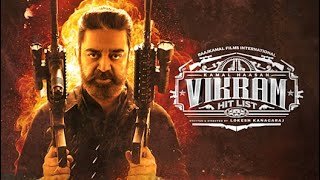Language: Tamil
Genre: Action Thriller / Crime Drama / Neo-noir
Director: Lokesh Kanagaraj
Starring: Kamal Haasan, Fahadh Faasil, Vijay Sethupathi, Narain, Suriya (cameo)
Franchise: Part of the Lokesh Cinematic Universe (LCU)
1. Overview – What Vikram Really Is
Vikram is not just a high-octane action thriller. It’s a multi-layered epic about violence, fatherhood, legacies, and masks. At its core, it is a battle between ideologies—between law and anarchy, between chosen families and blood ties, between ghosts of the past and forces of the future.
It’s a continuation and spiritual successor to Kamal Haasan’s 1986 film of the same name, but it reinvents itself as something far larger:
A cinematic universe where the underworld has gods, monsters, and a code of its own.
2. The World of Vikram: Blood, Brotherhood, and Borders
This is not your typical cop-versus-criminal film. The world of Vikram is almost mythic in tone—a concrete jungle ruled by cartels, where justice isn’t delivered by the system but by ghosts in the dark.
There are three power structures that shape the film:
- The System – Broken, weak, and often absent
- The Cartel – Led by Santhanam, powered by drugs and political reach
- The Ghost Squad – A shadowy paramilitary force fighting from the underground, led by the “dead” Vikram
The film unfolds as these three forces collide violently, leaving no one untouched.
3. Karnan / Vikram – The Ghost of Vengeance
Kamal Haasan’s character is introduced as Karnan, a frail, grieving father mourning his son’s death. But this is a mask. The real identity—Vikram—is slowly revealed:
A legendary black-ops officer, presumed dead, now operating off-grid to dismantle a narcotics empire that took his son’s life.
Vikram is a character forged in pain, silence, and shadows.
He’s not driven by justice, but redemption.
He’s not fighting for the state, but for the soul of the society he once served.
In him, we see:
- A father’s grief
- A soldier’s discipline
- A vigilante’s ruthlessness
- And a legend’s weight
He is not interested in surviving. He is interested in cleansing.
4. Amar – The Reluctant Seeker
Fahadh Faasil’s Amar is one of the most fascinating characters in the film.
Initially presented as a ruthless black ops leader, Amar’s character undergoes a transformation—from a dispassionate executor of state orders to a man questioning the very system he serves.
What makes Amar unique:
- He doesn’t know whom to trust
- He’s curious to the point of obsession
- He believes in patterns and logic—until he encounters Vikram, who rewrites the rules
His investigation into Karnan’s past becomes a path of spiritual awakening.
He begins hunting a ghost… and by the end, he joins it.
5. Santhanam – The Empire of Rot
Vijay Sethupathi plays Santhanam, a drug lord with animalistic energy, unpredictable rage, and a deep-rooted hunger for power and control.
Santhanam is not just a villain—he’s a symptom of societal collapse:
- He exploits government blind spots
- He commands soldiers, not thugs
- He builds an empire not from fear—but addiction and hopelessness
He is a character that embodies chaos with structure.
He wants to be a king, and Vikram threatens that dream.
Sethupathi brings an unhinged presence—his eyes burn with instability, his voice drips with sarcasm. He’s as dangerous when quiet as when he’s loud.
6. Thematic Depths: Legacy, Systems & Vigilantism
A. Legacy and Inheritance
The idea of fathers and sons echoes throughout:
- Vikram loses his son and fights to protect his grandson
- Amar steps into Vikram’s ideological shoes
- Santhanam breeds destruction, but his “kingdom” dies with him
The film asks:
What are we passing on to the next generation—trauma or purpose?
B. Systems Will Fail You
No police. No politics. No due process.
Vikram shows a world where systems are either broken or bought, and the only justice left comes from those outside the system.
Amar and Vikram both realize that operating within the rules won’t work. The world needs ghosts, not bureaucrats.
C. The Mask of the Dead
Vikram’s faked death and return mirrors a recurring idea:
Sometimes, to fight evil, you must cease being alive in the eyes of the world.
Masks are worn constantly:
- Vikram as Karnan
- Amar as a loyal officer
- Santhanam as a family man
But underneath, all are avatars of rage, guilt, and revolution.
7. Cinematic Language & Craftsmanship
Direction & Pacing
Lokesh Kanagaraj’s direction is taut, kinetic, and mythic. He crafts operatic action sequences with emotional grounding. Every shootout, every chase is character-driven, not just spectacle.
He constructs the narrative like a puzzle—the audience is piecing together Vikram’s true identity just as Amar is.
Visual Design
- Colors are moody and symbolic—reds and blacks dominate, echoing violence and secrecy
- The camera often hides as much as it reveals—mirroring the idea of ghost operatives
- Even urban chaos feels ritualistic, like mythological battles painted on concrete
Soundtrack and Score
Anirudh Ravichander’s score is a battle cry—the bass-heavy motifs, especially the “Vikram Title Track,” elevate scenes into legend.
It’s not just music—it’s ritual drumming before war.
8. The Suriya Cameo – Enter the Devil
In the final act, we meet Rolex, played with terrifying charisma by Suriya. Though he appears briefly, he leaves a massive impact.
Rolex is:
- The final boss of this underworld
- A man who deals in brutality, not business
- A symbolic next stage in the war Vikram and Amar are fighting
His entrance reshapes the stakes. Vikram’s war was local—Rolex’s empire is global. The real war, it turns out, is only beginning.
9. Conclusion – A Cult Epic in the Making
Vikram isn’t just a movie. It’s a foundation stone in a cinematic mythology.
It gives us:
- A tragic hero with mythic echoes
- A police officer turning into a disciple
- A villain who crumbles under ambition
- A criminal messiah waiting in the wings (Rolex)
It mixes mass entertainment with narrative depth, proving that action cinema can be philosophical, moral, and poetic.
In the end, Vikram is a question:
What happens when justice wears no badge, and only ghosts deliver vengeance?

